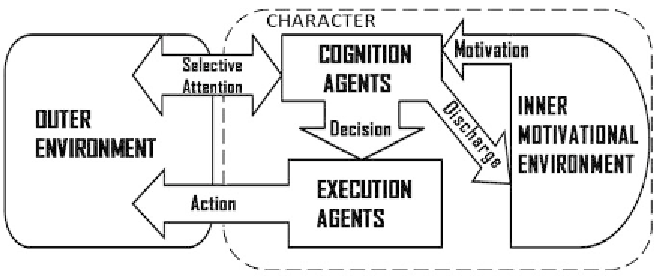Biomedical Engineering Reference
In-Depth Information
refined, until it reaches the decision. In the latter
case, an action is performed and the IME state
is altered accordingly.
Execution Agents represent the result of this
action selection mechanism. They are responsible
for all the “behavior as body movement” that the
character in question is capable of performing.
This means changing the environment, present-
ing an animation sequence, and altering the inner
state of the character according to the needs/de-
sires satisfaction or frustration. Figure 1 shows
the integration of the three agent sets and their
interface with the outer environment.
In the next topics the proposed architecture
is described in more details, and then a simple
example and some words of conclusion are given
about character design based on the proposed
architecture.
what motivations are going to be represented in
a character belongs to the art level of the system
creation, being a developer's decision. From the
point of view of the architecture, they are the driv-
ing forces of the behavior. As they code internal
processes, they don't have direct contact with the
environment. They affect and are affected only
by other character agents.
The main attribute of a Motivation Agent is its
Intention
, which represents a tendency to act in
certain way, possibly searching for some specific
object to satisfy it. Like in Sevin and Thalmann's
(2005) model, another important attribute is the
motivation
Intensity
i
, which is an internal vari-
able that reflects how much the corresponding
motivation is being significant at the current time.
This variable increases autonomously in time in
a rate determined by the motivation characteris-
tics. Again like the mentioned model, there are
two thresholds (
T
min
and
T
max
) that divide the
variable value range in three zones, here named:
comfort zone, tolerance zone and discharge zone.
The latter is renamed because it is not considered
as a
danger
zone, but instead it is just a zone
that demands some kind of urgent procedure to
decrease the Intensity value. Of course, motiva-
tion satisfaction is the more effective way, but
sometimes this is not possible. In such cases,
there must be an alternative way of doing it, which
is called the
Discharge Procedure
, and has to
Motivation Agents
Each Motivation Agent represents a specific
character motivation. It is a
reactive agent
, the
simplest class of agent (Mandiau and Strugeon,
2001), then having a relatively low computa-
tional complexity. A character motivation may
be anything: from simple basic needs (hunger or
thirst), to complex psychological and emotional
whishes (fame, success, love, etc.). Anyway, it is
coded with the same basic structure. Choosing
Figure 1. Multi-agent architecture for artificial mind

Search WWH ::

Custom Search